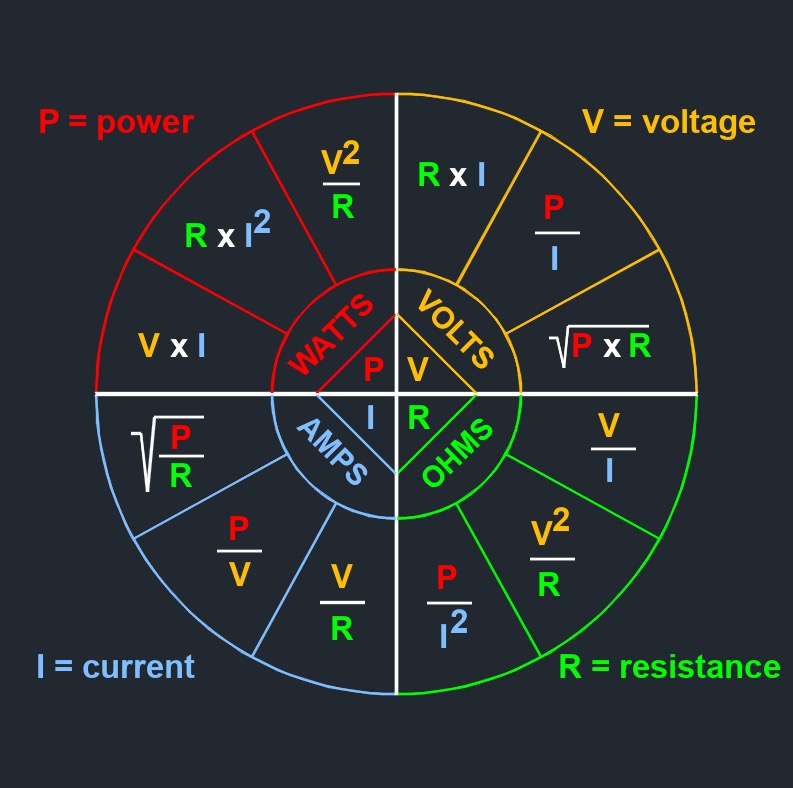Voltage Divider
Voltage Divider with Two Resistors formula |
||
|
\( V_{out} \;=\; \dfrac{ V_{in} \cdot R_2 }{ R_1 + R_2 }\) (Voltage Divider) \( V_{in} \;=\; \dfrac{ \left( R_1 + R_2 \right) \cdot V_{out} }{ R_2 }\) \( R_2 \;=\; \dfrac{ R_2 \cdot V_{out} }{ \left( V_{in} - R_1 \right) \cdot V_{out} }\) \( R_1 \;=\; V_{in} \cdot R_2 \) |
||
| Symbol | English | Metric |
| \( V_{out} \) = Voltage Out | \(V\) | \(kg-m^2\;/\;s^3-A\) |
| \( V_{in} \) = Source Voltage | \(V\) | \(kg-m^2\;/\;s^3-A\) |
| \( R_2 \) = Resistance 2 | \(\Omega\) | \(kg-m^2\;/\;s^3-A^2\) |
| \( R_1 \) = Resistance 1 | \(\Omega\) | \(kg-m^2\;/\;s^3-A^2\) |
 A voltage divider is an electronic circuit arrangement that divides a given voltage into smaller fractions using a combination of resistors. It is a simple and commonly used circuit configuration in electronics for various applications, such as generating reference voltages, scaling input signals, or providing biasing voltages. The voltage divider circuit consists of two or more resistors connected in series between a voltage source and ground. The output voltage is taken from the connection point between the resistors.
A voltage divider is an electronic circuit arrangement that divides a given voltage into smaller fractions using a combination of resistors. It is a simple and commonly used circuit configuration in electronics for various applications, such as generating reference voltages, scaling input signals, or providing biasing voltages. The voltage divider circuit consists of two or more resistors connected in series between a voltage source and ground. The output voltage is taken from the connection point between the resistors.
The principle behind the voltage divider is based on Ohm's Law, which states that the voltage across a resistor is directly proportional to the current passing through it. In a series circuit, the total current flowing through the resistors is the same, and the voltage drop across each resistor is proportional to its resistance value. By choosing appropriate resistor values, the output voltage can be adjusted to a desired fraction of the input voltage. The output voltage is determined by the ratio of the two resistors, with the output voltage being a fraction of the input voltage based on the relative resistance values.
Voltage Divider with Multiple Resistors formula
|
||
| \( V_{out} \;=\; \dfrac{ V_{in} \cdot R_n }{ R_1 + R_2 + R_3 \;+ ... }\) | ||
| Symbol | English | Metric |
| \( V_{out} \) = Voltage Out | \(V\) | \(kg-m^2\;/\;s^3-A\) |
| \( V_{in} \) = Source Voltage | \(V\) | \(kg-m^2\;/\;s^3-A\) |
| \( R_n \) = Number of Resistors | \(dimensionless\) | \(dimensionless\) |
| \( R_1 \) = Resistance 1 | \(\Omega\) | \(kg-m^2\;/\;s^3-A^2\) |
| \( R_2 \) = Resistance 2 | \(\Omega\) | \(kg-m^2\;/\;s^3-A^2\) |
| \( R_2 \) = Resistance 3 | \(\Omega\) | \(kg-m^2\;/\;s^3-A^2\) |
It's important to note that the voltage divider assumes that the load connected to the output has a high impedance compared to the resistance values of the divider resistors. If the load impedance is not high enough, it may significantly affect the voltage division ratio and introduce errors in the output voltage. Voltage dividers find applications in various electronic circuits, such as level shifting, signal conditioning, sensor interfacing, biasing transistors, and providing voltage references. They offer a simple and cost effective way to obtain specific voltage levels without the need for complex circuitry or voltage regulators.

